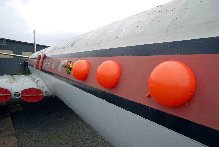EXPERTS fixing a 50-year-old aircraft have come up with a novel way of covering its windows during repairs – filling them with space hoppers.
The bouncy toys have been used to plug the windows of an iconic Comet jet airliner at the National Museum of Flight in East Lothian.
Conservation experts had been trying to figure out ways of keeping rain water out of the aircraft while they worked on it’s windows.
Space hoppers are fitted into the crafts windows Photo: Museum of Flight
Volunteer John Thomson, 63, suggested fitting the balls in the plane’s windows.
He first came across the technique while working as an engineer at Torness nuclear power station, where it was used to block pipes.
He borrowed some of the £10 toys from his granddaughters seven-year-old Jessica and five-year-old Kayleigh to test if they would work in the Comet 4C’s windows.
He said: “We’d tried a few things and they hadn’t worked out so it was nay port in a storm.
“It wasn’t my idea originally but I remembered back in the late 80s we had one of the first planned shutdowns at the plant.
“We had to clock off one of the water pipes and one of the guys came up with the idea of using a space hopper.
“I thought it might work here so we tried it with my granddaughters’ at first but they were too small for the size of the hole.
“We ended up getting some adult sized ones and luckily they fitted.
“We tried one and it stayed watertight for a week or so then we got the others.
“We lost a few in the heavy winds which was quite funny but in general it worked really well.”
The British-made Comet was the world’s first commercial jet airliner, but was plagued with disastrous crashes.
The plane on display at the East Fortune museum, the Comet 4C built in 1959, was the last version of the aircraft.
But it was rapidly overtaken by American-made Douglas and Boeing aircraft, and the plane fell out of widespread civilian use.
Volunteers at the museum had noticed rainwater was starting to enter through the windows and ruin the aircraft’s interior.
The windows and emergency exits were re-sealed, and the corrosion was treated in a four-month project.
Speed
Mike Loftus, assistant aircraft and technology conservator, said John’s technique has sped up work by weeks.
He said: “When John first suggested it I though he was a bit mad to be honest.
“Then he brought one in and showed its wonderful expandable qualities and it was like a lightbulb moment.
“It was a fantastic solution. We got it down to a fine art of inflating them first and then putting them in the holes.”
He continued: “The interior of the Comet is very 60s-70s. When the sunlight shone through, it lit up the aircraft with an orange glow.
“It looked quite spectacular.
“I’ve since heard it’s standard engineering practice to use inflatable devices but I’d never heard of it.
“I think it was a well-kept secret until now.”
Space hoppers were an invention of the 1960s, and were first marketed in Britain as “an amazing inflatable riding ball.”
Originally called PON-PON, it was invented by Italian Aquilino Cosani.
